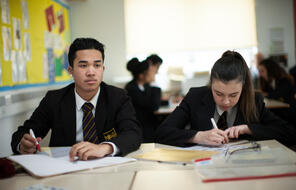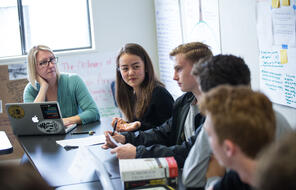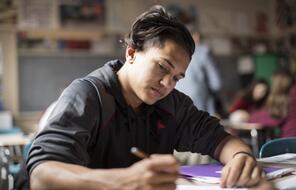%20(1).png?h=d3d13267&itok=RJS3A0Jw)
By asking the question "Who am I?" students explore the role that identity plays in forming their values, ideas, and actions.
“Who am I?” is a question we all ask at some time in our lives. It is an especially critical question for adolescents. As we search for answers we begin to define ourselves. How is our identity formed? To what extent are we defined by our talents and interests? by our membership in a particular ethnic group? by our social and economic class? by our religion by the nation in which we live? How do we label ourselves and how are we labeled by others? How are our identities influenced by how we think others see us? How do our identities inform our values, ideas, and actions? In what ways might we assume different identities in different contexts? How do we manage multiple identities? Answers to these questions help us understand history, ourselves, and each other.
As students study world history, they will explore how individuals and groups over time and across continents have answered questions about identity. They will learn that many of the same factors that influence their identities—factors such as religion, gender, and geography—also shaped the identities of the ancient Greeks, the Mayans, and the Chinese. Thus, this lesson establishes an important social studies theme that will resonate throughout the year.
At the same time, beginning the year by having students examine and share their own identities is a way to build relationships in your class. When sixth grade students begin a new school year, often with unfamiliar classmates and teachers, it is particularly important for them to have the opportunity to get to know their new community and to become known by others. The activities suggested in this lesson begin this process of relationship building.
This lesson is designed to fit into one 50-min class period and includes:
Before you teach this lesson, please review the following guidance to tailor this lesson to your students’ contexts and needs.
Teaching NoteCreate an Identity Chart
In preparation for this class, you may want to create your own identity chart. Not only will this model the assignment for students but it also provides a way for students to get to know you. Throughout this unit there are opportunities for you to work alongside the students to reinforce the idea that you are a member of their classroom community too.
Use identity charts to help students consider the many factors that shape their own identity and that of groups, nations, and historical and literary figures.
%20(1).png?h=d3d13267&itok=RJS3A0Jw)
When students begin a new school year they may hold contradictory feelings. On one hand, they may think they know a lot about their classmates just by looking at them. They may have formed judgments about who will (or will not) be their friends based on the clothes people wear or how they speak. On the other hand, students may feel they are in the company of strangers; they may feel that nobody really knows them and that they don’t really know their classmates. To help students push beyond judging their peers based on simple stereotypes, you can have them participate in a “How well do we know each other?” activity.
First, distribute an index card to each student. Ask students to write one little-known fact about themselves on this card. It should be something that people could not know just by looking at them. Their names should not appear on the cards. Then collect the cards.
Read a card and ask the class to guess who the fact describes. You might read several cards at the beginning of each class period throughout this unit. Through this activity students often learn that they have something in common with a classmate or they learn something interesting about someone that might otherwise have taken all year to discover.
Activity 2In the next several lessons, students will focus on the concept of identity. Write the word identity on the board and ask for volunteers to share their thoughts on what it means. Or
you can share this definition with students: Identity is the answer to the question, “Who am I?” The fact students wrote on their index cards in the warm-up activity represents one part of students’ answer to this question.
Next, read “My Name,” a chapter from Sandra Cisneros’s book The House on Mango Street. In this excerpt a young girl, Esperanza, reflects on her name. In the process she reveals information about her identity—how she perceives herself, what she values, where her family is from, and so on. Ask student volunteers to read a paragraph of this excerpt to the class. As the text is read aloud, students can underline any words or phrases that give them information about how Esperanza would answer the question, “Who am I?”
In small groups, have students create an identity chart for Esperanza. The diagram on the next page is an example of an identity chart. Students can begin with the words orphrases they underlined in the passage that represent how Esperanza defines her identity.
You can also provide groups with some questions to guide them:
Alternatively, you can create Esperanza’s identity chart as a whole class activity.
Curriculum connection: Students can create identity charts for historical figures as well as for civilizations and nation-states. For example, have students create identity charts for Athens and Sparta or for Montezuma or Siddhartha.
The purpose of reading “My Name” is to help students think about the various factors that shape our identities. However, the text also introduces other interesting themes such as the concepts of stereotypes and prejudice. Later in this unit, students will have the opportunity to address questions such as, “How do we perceive and judge others?” and “How does it feel to be labeled?” For now, you can frame questions about the way Esperanza describes Mexicans, Chinese, and women in terms of what this says about her own beliefs and experiences.
Activity 3Now students can create identity charts for themselves. Before beginning this activity, ask students to brainstorm a list of categories people use to help define themselves such as gender, age, physical characteristics, and hobbies as well as ties to a particular religion, ethnic group, neighborhood, and nation. Explain to students that they will be sharing their identity charts with the class so they should be cautious about including information that they want to remain private. In the next few lessons, students will have the opportunity to think more deeply about their own identities. As they gain a deeper understanding of identity, they will add to their identity charts. Their identity charts willalso serve as useful prewriting tools for future assignments such as students’ bio-poems.
Homework 1Students create a plan for enacting change on an issue that they are most passionate about using the 10 Questions Framework.

Students explore the potential negative impact of images through the social media protest #IfTheyGunnedMeDown and develop a decision-making process for choosing imagery to represent controversial events.

Students explore how identity impacts our responses to other people and events by examining a cartoon and analyzing an opinion poll from a week after Ferguson.

Students examine how identity and biases can impact how individuals interpret images and experience the challenge of selecting images to represent news events, particularly connected to sensitive issues.

Students establish a safe space for holding sensitive conversations, before introducing the events surrounding Ferguson, by acknowledging people's complicated feelings about race and creating a classroom contract.

Students explore the role of social media in Ferguson, apply information verification strategies to social media posts, and develop strategies for becoming critical consumers and sharers of social media.

Students identify strategies and tools that Parkland students have used to influence Americans to take action to reduce gun violence.

Students evaluate the differences among news accounts about Ferguson, develop strategies for verifying news and information, and understand the challenges facing journalists as they cover complex, fast-moving events.

Help students become informed and effective civic participants in today's digital landscape. This unit is designed to develop students' critical thinking, news literacy, civic engagement, and social-emotional skills and competencies.

Through a mask-making activity, students learn that they can conceal or reveal aspects of their identity.

Students draw on a classic Dr. Seuss story to explore how communities make choices regarding membership.

Students create classroom rules through a group activity, and learn the relationship between customs and laws as it relates to a safe learning environment.

Facing History & Ourselves is designed for educators who want to help students explore identity, think critically, grow emotionally, act ethically, and participate in civic life. It’s hard work, so we’ve developed some go-to professional learning opportunities to help you along the way.
Professional LearningListen to #DisruptTexts founder Julia Torres about taking a critical lens to text selection in ELA classrooms.

Listen to writer and educator Dr. Clint Smith as he shares his poetry and reflections on working for justice, equity, and civic agency in our schools.

Explore approaches to centering student voice, building authentic relationships and cultivating community with Molly Josephs, the creator of This Teenage Life, a youth-driven, story-sharing podcast that started as a school club.